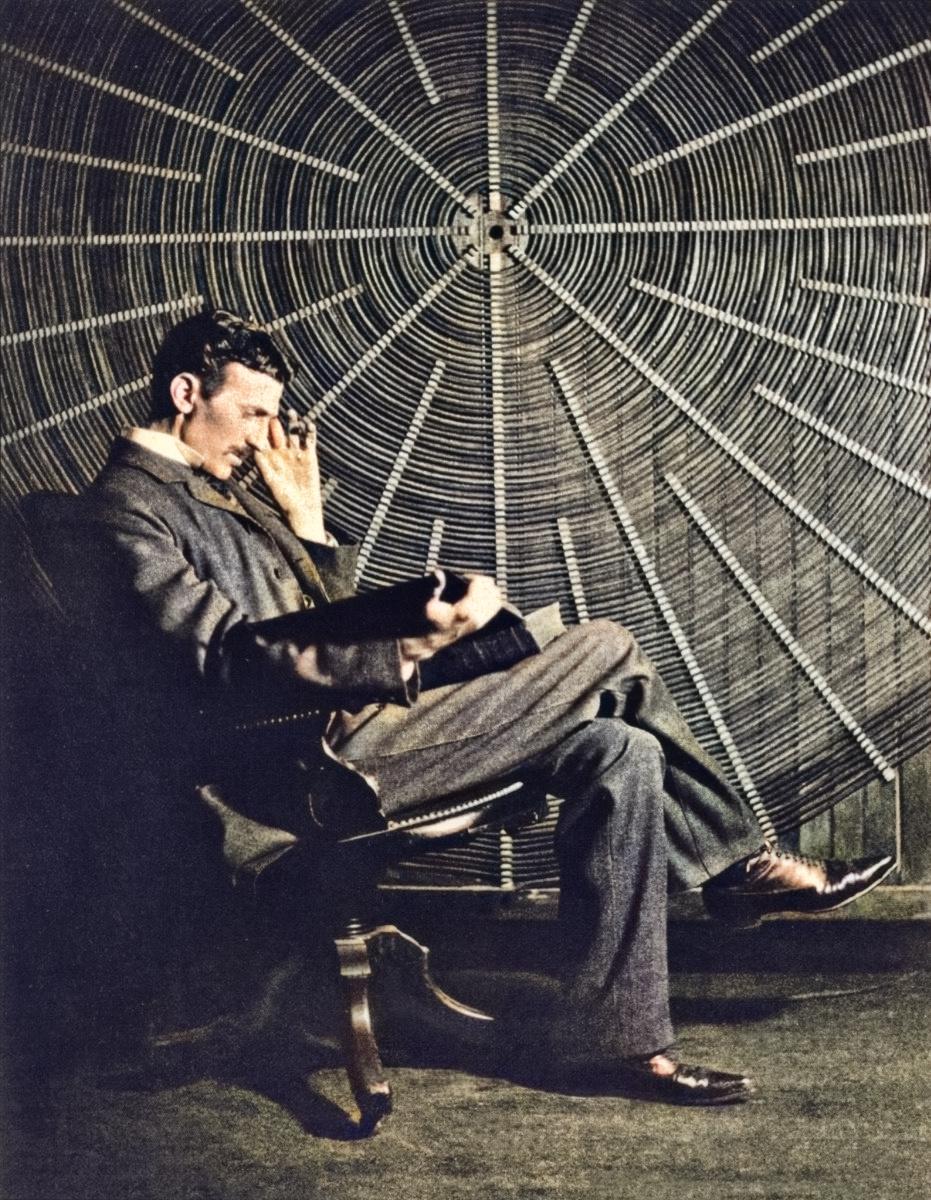
Nikola Tesla (1856 – 1943)
On July 10, 1856, Serbian-American inventor, electrical engineer, mechanical engineer, physicist, and futurist Nikola Tesla was born. He is probably best known for his contributions to the design of the modern alternating current (AC) electricity supply system. Although his work fell into obscurity after his death, he experienced a renaissance in the popular culture of the late 1990s, becoming a center of many conspiracy theories including UFO theories and New Age occultism. In 1960, in honor of Tesla, the General Conference on Weights and Measures for the International System of Units dedicated the term “tesla” to the SI unit measure for magnetic field strength.
“Throughout space there is energy. Is this energy static or kinetic! If static our hopes are in vain; if kinetic — and this we know it is, for certain — then it is a mere question of time when men will succeed in attaching their machinery to the very wheelwork of nature.”
– Nikola Tesla, “Experiments With Alternate Currents Of High Potential And High Frequency” (February 1892)
Gambling and Missed Exams
Nikola Tesla was born as the fourth of five children of Serbian parents in the village Smiljan in the Lika not far from Gospić in today’s Croatia. His parents were the Orthodox priest Milutin Tesla (1819-1879) and his wife Georgina (call name Đuka, born Mandić, 1822-1892). Already during his school years, Tesla’s talents were noticed. He was able to perform integral calculus in his head, wherefore the teachers often assumed he was cheating. But even though his father wanted him to become a priest, Nikola Tesla was sent to the Austrian Polytechnic in Graz where he glanced with his extraordinary grades and his expertise. Unfortunately, he began gambling in later semesters and was never able to graduate since he lost his scholarship and missed several exams.
First Working Experience
Tesla moved to Marburg an der Drau, where he found employment as a mechanical engineer. He spent his free time as a card and billiard player in relevant pubs. On March 24, 1879, Tesla was expelled from Marburg/Maribor by police order and sent back to his home parish Gospić . A month later, in April 1879, his father died. After Tesla’s death, he stayed in Gospić and took a job as a substitute teacher. In 1880, Tesla went to Prague with the financial support of his uncle Dane Branković to complete his studies at the Charles University there, which at the time was a German-speaking university. However, neither the attendance nor the completion of the lectures attended by him is documented; even the necessary tuition fees were never paid. From 1881 to 1882 Tesla lived in Budapest, where in 1882 he was employed as a telegraph technician by Tivadar Puskás, who at that time was the representative of Thomas Alva Edison’s companies in Europe. With a recommendation from Puskás, Tesla moved to Paris at the end of 1882 to join Charles Batchelor, who operated one of the leading Edison companies in France. In addition to other activities, Tesla supervised the newly installed electric lighting at the Gare de l’Est in Paris from November 1883 to February 1884.
From Edison to Westinghouse
On 6 June 1884 Tesla moved to New York with practically no financial means. Only two days later, on 8 June 1884, he began to work for Thomas Alva Edison.[5] While starting at simple electrical engineering tasks, Tesla soon started solving the company’s most difficult problems. Tesla and Edison soon had several disagreements considering Teslas work and his payment, wherefore he resigned after only two years, which led Tesla to found his own company, but failed. He gave it another try in the late 1880’s and was able to construct an alternating current motor, which he received the patent for. From July 1888 to July 1889, Tesla worked together with Westinghouse technicians in Pittsburgh on practical implementations of AC voltage systems – several patents date from this time, including the conversion of direct current into alternating current. The cooperation was not free of conflict: Tesla was used to working as a “lone fighter” and had difficulty integrating himself.
High-Frequency Alternating Currents
In August 1889, after a brief European stay in Paris and his home town of Gospić, Tesla moved to New York, where he set up a laboratory on Grand Street and began to study high-frequency alternating currents and electromagnetic waves. The idea that Tesla was pursuing at the time and that he would never let go of for the rest of his life was to enable wireless energy transmission by means of high-frequency alternating currents. He experimented with Geißler tubes, an early form of the gas discharge tube, and held regular demonstrations in which he let the Geißler tubes light up without a cable connection between electrodes installed in the room.
The World’s Columbian Exhibition
Despite the economic crisis in the USA in 1893, Tesla’s Egg of Columbus was exhibited at the World’s Columbian Exposition in Chicago (this world exposition was dedicated to the discovery of America by Christopher Columbus) by Westinghouse. This demonstration setup was intended to illustrate the effect of the rotating magnetic field by means of a metallic egg and its rotation and to create a mood for the alternating current system represented by Westinghouse within the framework of the current war.
X-Rays, Submarines, and Radio Transmission
In 1896, Tesla was occupied with the then newly discovered X-ray radiation. In 1897, he again devoted himself intensively to the ideas of wireless energy and message transmission,[26] which to a certain extent were in competition with the work of the radio pioneer Guglielmo Marconi. At that time Tesla was also working on other topics, such as a 1.1 metre long unmanned submarine that could be remote controlled wirelessly and was to be used in the Spanish-American War loaded with explosives, but was never used. On March 20, 1900, Tesla received his first patent for wireless energy transmission, which is now regarded as the first patent in radio technology, although he wanted to use it to transmit energy to lighting. After Guglielmo Marconi sent the first transatlantic radio transmission in 1901, Tesla was cited but a large patent battle between the two inventors evolved.[6]
El Paso Laboratory
Inspired by his patent attorney, who owned shares in the El Paso Electric Company in Colorado Springs, Tesla built a larger laboratory in May 1899 in the then sparsely populated area around Colorado Springs. Tesla wanted to use the planned systems to wirelessly transmit “news and energy” from the east coast of the USA to a planned receiving station in France by the time of the World Exhibition in Paris in 1900. The wooden laboratory contained various coils and superstructures and in the middle an iron mast that could be extended to a height of 50 m to capture lightning discharges. In his experiments with lightning discharges, he also described the standing waves occurring in the low-frequency range in the atmosphere, which are today called Schumann resonance. During his experiments in Colorado Springs, artificial and natural lightning discharge repeatedly set parts of the laboratory on fire. In October 1899, Tesla increased the output to such an extent that the generator of the El Paso Electric Company burned through and the city of Colorado Springs had no electricity for days.
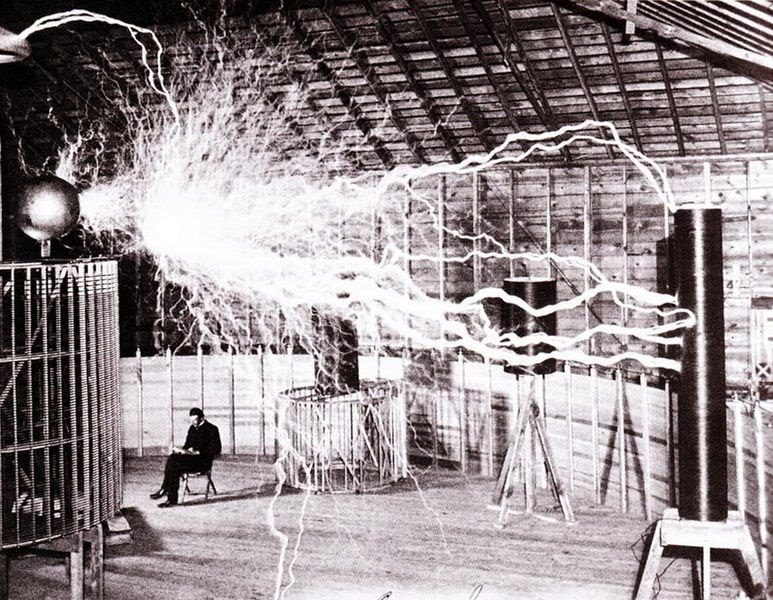
A multiple exposure picture of Tesla sitting next to his “magnifying transmitter” generating millions of volts. The 7-metre (23 ft) long arcs were not part of the normal operation, but only produced for effect by rapidly cycling the power switch
Increasingly Bizarre Ideas
After 1900, Tesla’s work became increasingly bizarre, with a tendency towards transcendentalism and areas of metaphysics. In the middle of 1900 he published a dissipated article in Century Magazine on increasing human energy under the title The Problem of Increasing Human Energy, in which the representative of an energetic vegetarianism[33], who also advocates a vegetarian diet, drew an apocalyptic prophecy about the present and future of mankind and, above all, proposed the utilization of solar energy as a “natural source of energy for mankind”. The article, which also refers to a Tesla patent on a “world energy system”, provoked strong criticism in professional circles and the media, including major US newspapers, in which it was described as a dreamer and impractical inventor. Tesla was not impressed and claimed in the January 1901 issue of the US magazine Collier’s Weekly that he had had first contact with aliens as early as 1899. In March 1901 he applied for a patent for an apparatus for the use of radiant energy with US Patent No. 685.957, which was to collect “space energy” and convert it into electrical energy.
The Tesla Turbine and Later Life
His situation improved in 1908 with the invention of the Tesla turbine, a form of the disc pump, which aroused the interest of John Hays Hammond, who had become rich in gold mining. With the new investor he was able to found the Tesla Propulsion Company in New York. At the end of 1913 Tesla tried to sell prototypes of its Tesla turbine to the Bergmann-Elektrizitätswerke in Germany, but failed due to transport costs. In 1916 he patented his Tesla valve, which was based on the fact that the flow resistance in one flow direction was lower than in the opposite, thus achieving a rectifier effect. At that time Tesla also wrote various publications on the subject of war technology. In August 1917, for example, the journal Electrical Experimenter published an article dealing with fantastic weapon systems against submarines. He wanted to send out “concentrated beams of high frequency”.
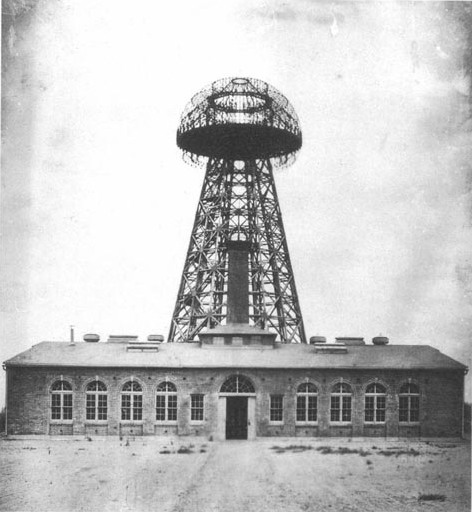
Tesla’s Wardenclyffe plant on Long Island in 1904. From this facility, Tesla hoped to demonstrate wireless transmission of electrical energy across the Atlantic.
Radiation Cannons and Death
Around 1930, as a result of the economic crisis, Tesla could hardly make a living and lived on credit in New York hotels. In 1933, the Westinghouse Company agreed to pay him a monthly sum for his advisory services. On January 1, 1934, he moved to the Hotel New Yorker. At the end of his life as an inventor he retired more and more and dealt among other things with “radiation cannons” around 1935. Tesla was found dead on the morning of 8 January 1943 at the age of 86 in the Hotel New Yorker by staff at the age of 86; the doctor entered 7 January 1943 in the death certificate as the time of death. As Nikola Tesla’s achievements were often overlooked during his lifetime, he became a very tragic figure. He was often socially isolated due to his own wish and known as a workaholic for all his life. In later years after his passing, his brilliance was finally noticed and his name now stands for numerous technical improvements and inventions.
“Let the future tell the truth and evaluate each one according to his work and accomplishments. The present is theirs; the future, for which I really worked, is mine.”
– Nikola Tesla, On patent controversies regarding the invention of Radio and other things, as quoted in “A Visit to Nikola Tesla” by Dragislav L. Petković in Politika (April 1927);
Idea and Illusion: The Rise and Fall of Nikola Tesla – W.B. Carlson – 11/12/2020, [10]
References and Further Reading:
- [1] The Nikola Tesla Museum
- [2] Nikola Tesla at Britannica Online
- [3] TED Talk On Tesla
- [4] Tesla Life and Legacy – Tesla’s Early Years
- [5] Mary Had a Little Lamb – Edison and the Phonograph, SciHi Blog
- [6] Guglielmo Marconi and his Magic Machine , SciHi Blog
- [7] Online archive of many of Tesla’s writings, articles and published papers
- [8] Works by or about Nikola Tesla at Internet Archive
- [9] Nikola Tesla at Wikidata
- [10] Idea and Illusion: The Rise and Fall of Nikola Tesla – W.B. Carlson – 11/12/2020, caltech @ youtube
- [11] Tesla, Nikola (20 May 1891). Experiments with Alternate Currents of Very High Frequency and Their Application to Methods of Artificial Illumination., lecture delivered before the American Institute of Electrical Engineers, Columbia College, New York.
- [12] Tesla, Nikola, My Inventions, Parts I through V published in the Electrical Experimenter monthly magazine from February through June 1919.
- [13] Timeline for Nikola Tesla, via Wikidata


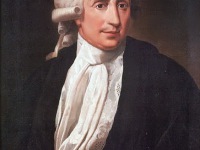
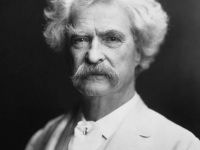
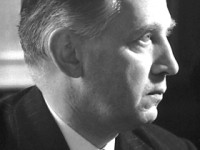

Pingback: Whewell’s Gazette: Year 3, Vol. #21 | Whewell's Ghost
Pingback: Whewell’s Gazette: Year 3, Vol. #48 | Whewell's Ghost